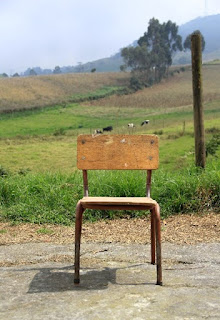 |
Photo by Adrian "Rosco" Stef on Unsplash |
Smoking used to be the only big no-no. Going back thirty-five years, the second-hand smoke in a large restaurant or pub was so bad it was hard to see the far wall. I am heavily into music, but I couldn’t see the point of endangering my health while I was entertained. I can protect my ears but wearing a mask back then, hmmm—think about the bouncers.
But, when enough smokers finally got the message or gave up because of the cost, the health police turned their attention to the bottle. But this wasn’t about the level of abuse seen in film—think Crocodile Dundee. Instead, it questioned the tradition of ‘quiet ones’ with mates after work, after which you go home largely unaffected. Quite recently, a study concluded there is no safe limit on alcohol usage. Teetotallers applauded. Viticulturalists groaned. I thought, what next?
Sitting kills you
Well, the answer is ‘sitting’, described by a state government as the new smoking. It’s just no good to sit. Mind you, bus drivers will still bark ‘sit down’ to the unruly students at the back of the bus!
But (a little) more seriously, I get it that today’s society sits way too much, usually bingeing subscription TV. We can probably blame the Pandemic for that as well, but most can easily go back to normal programming and binge as a change-up. That same government department tells us sitting increases the risk of all the chronic health problems that smoking and drinking cause. Sitting and drinking is definitely not a good cocktail!
 |
| Photo by eduard on Unsplash |
Personally, I think life is the riskiest condition. The dead don’t have any of these problems. That said, desk jobs are ‘sit’ jobs. Apparently, sit-stand desks need to be ‘installed’ and thus cost employers much more than desks with limited adjustments. In my paid job, I sit and leer at my computer. Don’t be envious, the only scurrilous content is ‘classified’, but working supports my writing habit—or should that be ‘sitting’ habit.
If I lynch the thought police, will the problem go away? Well, not for me, obviously.
Avoiding the dangers
So, are there ways around the conundrum? Schooling trained me to sit while writing and studying; and that first learned is the hardest to unlearn. So, be kind to yourself if you make a lifestyle change. It will take practice and persistence.
The anti-sitting crusaders will suggest all sorts of activities that won’t mix with writing, because they are aiming at the big targets. They recognise that many jobs are seat-bound, so they would want you to be doing sport or walking your dog and letting your TV on-demand subscriptions go. But that doesn’t mean you should shove your derriere into the plush sofa and block them from your hearing entirely.
You may have to sit to write, but you can limit your sitting by using a sit-stand desk or two surfaces set up properly—one at sit height and one at stand height—which you swap between.
But you are not constrained to a desk.
You can use voice to text. Most smart phones support voice to text. You may have heard of Dragon, but you don’t need the Rolls to do what a Hyundai does. I’ll back out of that metaphor. We are discussing voice to text apps. I use Otter, which is designed as a note-taking app for meetings. Otter ai has a great free version. The basic free plan will stop your recording at exactly 30 minutes, but—when I last checked—you’re not limited on the number of sessions. You then play the text of your voice and correct what Otter heard, which is usually what you spoke unless you are in a noisy environment.
 |
| Photo by Pawel Czerwinski on Unsplash |
You can stand up to do all of this.
If you use voice to text, you do not have to sit to write. Go for a walk and write. You can use it for shopping lists as well!
Voila! You have your writing.
It uses a different brain pathway as it’s via voice, not fingers. But that can be freeing, too.
Efficient sitting
Another way to limit sitting is to write in sprints. Done well, it’s also an efficiency gain. The pomodoro method can be applied to any task but works especially well with writing. First, stand up and think through what you want to write. Then set a strict time limit—25 minutes is recommended. Sit and write. When the timer buzzes, stop writing, stand up, be lightly active. Repeat as required.
 |
| Photo by Braden Collum on Unsplash |
Think while standing, set the timer, then sit. Watch your posture but write hard.
Live long and prosper your writing!
Have you got any good ideas?
 |
| Marc Z Jeffrey writes suspense and thrillers when he is not working for the Australian public service. He loves editing fiction and can spot an errant apostrophe at a thousand paces. |

Quite a few decades ago, I used a sitting device obliquely designed pour-la-derriere (in the feminine!), balanced by knees on a forward cushion. Took some getting used to, kept my back straight, and became 'kneely' uncomfortable way too soon.
ReplyDeleteI appreciate Marc's several options for efficient non-fatal sitting. I'm going to take on-board the 25 minute pomodoro method, as I used to abide by the 2 hours sit-then-rise'n-stretch, which is jaggedly performed by less active, aging derrieres. Thanks Marc.
I remember that kneeling chair. Sorta cut off the circulation in the legs! It was one of those 1980s almost-good inventions!
Delete